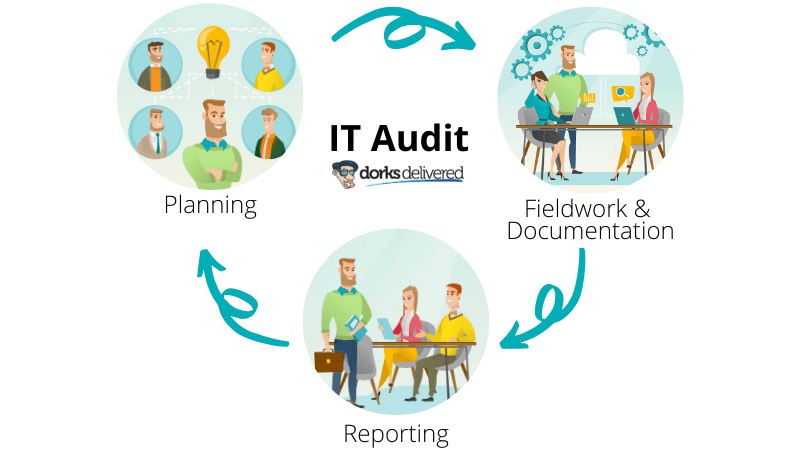Why Do You Need to Understand the IT Audit Process?
So, you are now convinced that business owners in Australia are not exempt from cyberthreats. You made a choice and decided that an IT security audit process is necessary for your growing business. You sit down with your IT audit team, set your objectives and discuss the process. But then you realise, after all these efforts, how can you make sure your IT audit process will give great results?
Talk to a Dork to learn more about IT audit. Schedule your free initial consultation!
What Are the Basic Steps Involved in an IT Audit Process?
It is necessary to understand the process so that you can prepare for the succeeding steps. The phases involved in an IT audit process are as follows:
Planning Phase
Among all the steps involved in an IT audit process, this phase is the most important and will typically take up the most time. It is usually divided into two stages: the pre-planning stage and the final planning stage.
You May Also Like: What You Need to Keep in Mind When Planning for a Disaster
At the pre-planning stage, the following steps take place:
1. Conduct a Risk Assessment
The IT auditors will sit down with you to talk about your business and to give you an idea about the cyber threats that commonly affect companies in your industry. From there, you will agree on the scope of their work.
2. Identify Regulatory Compliance Requirements
The audit should always comply with what is required by ISACA. By understanding the purpose of the audit, IT experts can identify what type of report should be issued once the process is completed.
3. Determine the Resources Needed
Does the audit require the presence of an IT specialist like an Information Security Manager? Or will an Information Systems Auditor suffice? Identifying the people and resources needed will help ensure higher quality on the work involved.
At the final planning stage, the auditor will determine the procedures and methods for data gathering. Your company’s current IT policy will be collected and reviewed, and plans for testing current IT controls will be developed.
At the final planning stage, the auditor will determine the procedures and methods for data gathering. Your company’s current IT policy will be collected and reviewed, and plans for testing current IT controls will be developed. 
Talk to a Dork and get help in planning your IT audit. Schedule your free initial consultation!
Fieldwork and Documentation Phase
The next phase of the IT audit process is fieldwork and documentation. The auditors will begin gathering data and testing IT controls and procedures to validate their effectiveness.
As this step could sometimes require an auditor to make a subjective judgment on a control’s effectiveness, the auditor’s experience will play a crucial role. Hence, it’s essential to review their credentials when you choose which IT auditor will work on this project.
You May Also Like: Network Documentation Best Practices and Checklist
Reporting Phase
Once the auditor has ticked all of the items on the IT process audit checklist during the first two phases, all findings will be gathered. In the final phase of the IT audit process, a report compliant to the regulatory requirement will be issued. This is the culmination of the entire process and should meet the goals set during the initial planning phase.
Talk to a Dork to learn more about IT audit. Schedule your free initial consultation!
How Can You Tell If the IT Audit Process Is Effective?
When your audit objectives are met, that’s when you can say that the IT audit process has been effective. Therefore, the right audit objectives must be set at the planning phase to address your company’s current and future needs. As a business owner, you should remember that these are your primary concerns when setting your audit goals:
• An evaluation of your company’s current IT infrastructure to determine the level of security it provides
• An assessment of the level of risk your company’s information assets face
• An audit of your information management procedures to check if they are compliant to IT-specific laws, policies and standards
• A system check to find inefficiencies and a solution for these issues
• A discussion on methods to minimise the likelihood of experiencing cyberattacks
You May Also Like: IT Audit Checklist: Why Do You Need It?
The Final Word
The effectivity of an IT audit process hinges on how audit objectives are set. However, it is not dependent on just one process, but on the proper execution of each phase. Therefore, you must choose a competent IT team to conduct the audit. This will increase the likelihood of you achieving your audit goals.
[module-379]




























